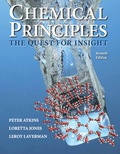
Concept explainers
(a)
Interpretation:
The balanced chemical equation for the reaction between aluminium oxide and hydroxide ion has to be written.
(a)
Answer to Problem 8E.4E
The balanced chemical equation for the reaction between aluminium oxide and hydroxide ion is,
Explanation of Solution
Aluminium oxide reacts with hydroxide ion and water to form
Two moles of hydroxide ion, three moles of water are required in the reactant side and two mole of
(b)
Interpretation:
The balanced chemical equation for the reaction between aluminium, hydronium ion and water has to be written.
(b)
Answer to Problem 8E.4E
The balanced chemical equation for the reaction between aluminium, hydronium ion and water is,
Explanation of Solution
Aluminium reacts with hydronium ion and water to form
Six moles of hydronium ion, three moles of water are required in the reactant side and two moles of
(c)
Interpretation:
The balanced chemical equation for the reaction between boron and ammonia has to be written.
(c)
Answer to Problem 8E.4E
The balanced chemical equation for the reaction between boron and ammonia is,
Explanation of Solution
Boron reacts with ammonia to form boron nitride with the evolution of hydrogen gas. The chemical reaction is,
Two moles of boron, two moles of ammonia are required in the reactant side and two moles of boron nitride and three moles of hydrogen are required in the product side to make the reaction a balanced one. The balanced chemical equation for the reaction between boron and ammonia is,
Want to see more full solutions like this?
Chapter 8 Solutions
EBK CHEMICAL PRINCIPLES
- Write the chemical equations that describe the following procedures: (a) Preparation of acetic acid with carbon and water raw materials. (b) Atmospheric ozone depletion by Freon 12. (c) Preparation of hydrazine with raw materials ammonium chloride and calcium hydroxide. (d) Preparation of nitric acid from gases N2, H2 and O2.arrow_forwardWrite and balance the chemical equation that represents the reaction of sulfuric acid with sodium hydroxideto form water and sodium sulfate.arrow_forwardWrite an equation to show that nitrous acid , HNO2 , behaves as an acid in water. ____ + H2O → ____ + ____arrow_forward
- What is the structure? The chemical formula is C8H14O3arrow_forward(a) How does the metallic character of an element correlate with the acidity of its oxide? (b) What trends, if any, exist in ox-ide basicity across a period and down a group?arrow_forwardWhich one of the following is the most basic oxide? a. Bi2O3 b. N2O3 c. P4O6 d. As4O6arrow_forward
 Chemistry by OpenStax (2015-05-04)ChemistryISBN:9781938168390Author:Klaus Theopold, Richard H Langley, Paul Flowers, William R. Robinson, Mark BlaserPublisher:OpenStax
Chemistry by OpenStax (2015-05-04)ChemistryISBN:9781938168390Author:Klaus Theopold, Richard H Langley, Paul Flowers, William R. Robinson, Mark BlaserPublisher:OpenStax Chemistry: Principles and PracticeChemistryISBN:9780534420123Author:Daniel L. Reger, Scott R. Goode, David W. Ball, Edward MercerPublisher:Cengage Learning
Chemistry: Principles and PracticeChemistryISBN:9780534420123Author:Daniel L. Reger, Scott R. Goode, David W. Ball, Edward MercerPublisher:Cengage Learning Chemistry: The Molecular ScienceChemistryISBN:9781285199047Author:John W. Moore, Conrad L. StanitskiPublisher:Cengage Learning
Chemistry: The Molecular ScienceChemistryISBN:9781285199047Author:John W. Moore, Conrad L. StanitskiPublisher:Cengage Learning


